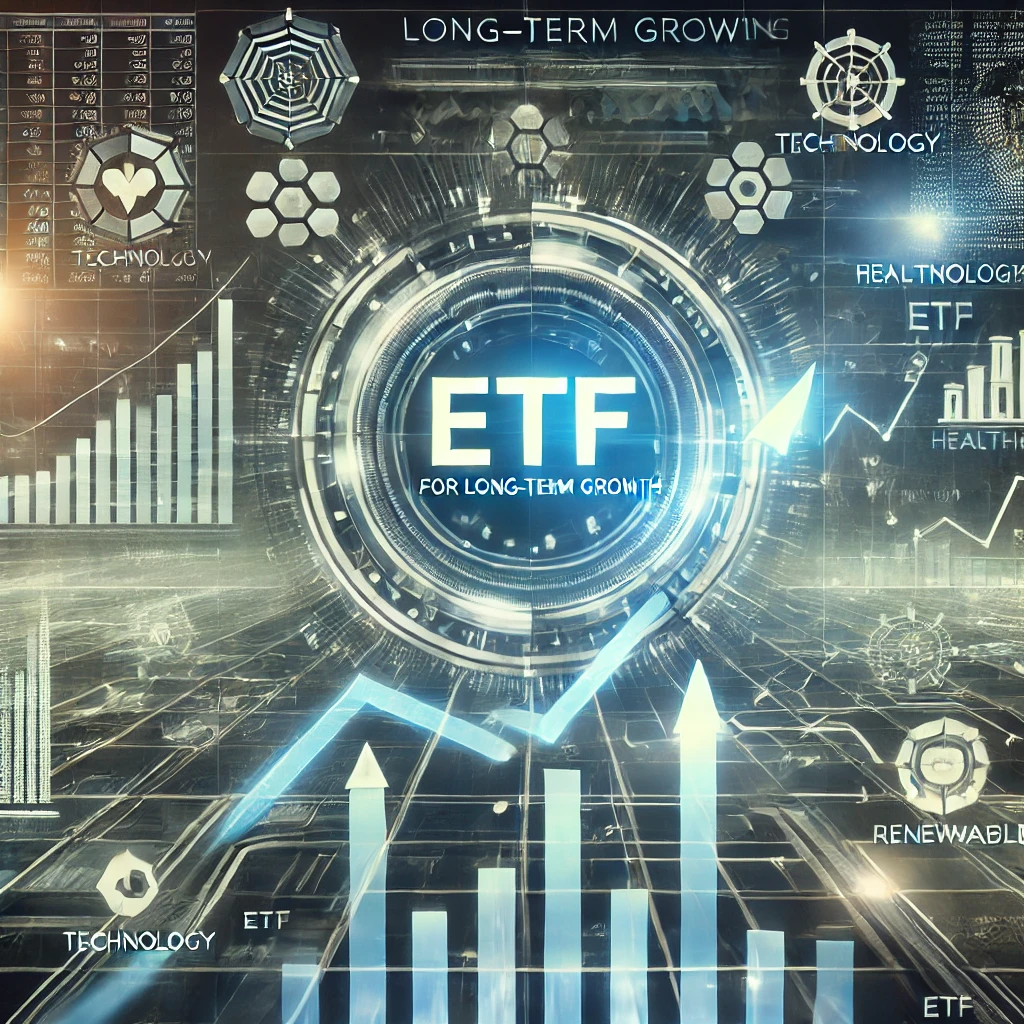Best ETFs for Long-Term Growth in 2025 – Exchange-Traded Funds (ETFs) have emerged as one of the best investment vehicles for individuals looking to grow their wealth over the long term. These funds offer diversification, cost efficiency, and ease of trading, making them highly attractive for both beginner and experienced investors. The best ETFs for long-term growth typically consist of stocks with strong growth potential, spanning across various sectors and geographical regions. As we enter 2025, market conditions, economic trends, and technological advancements will play a key role in determining which ETFs will offer maximum returns over time.
Investing in ETFs for long-term growth requires a strategic approach. It’s essential to consider factors such as expense ratios, historical performance, sector allocation, and risk management. Growth-focused ETFs are typically composed of high-performing companies that reinvest earnings into expansion, innovation, and market dominance. Investors should also evaluate macroeconomic trends, including interest rates, inflation, and global trade policies, which can impact the overall performance of these funds. Understanding these factors will help investors make informed decisions when selecting ETFs for their portfolios.
In this guide, we will explore the best ETFs for long-term growth in 2025, covering broad market ETFs, sector-specific ETFs, international ETFs, and dividend growth funds. We will also provide insights into portfolio diversification strategies and risk management techniques to help investors maximize their returns. Whether you are a seasoned investor or just starting your journey, this comprehensive guide will help you build a solid ETF portfolio that aligns with your financial goals.
Best ETFs for Long-Term Growth in 2025: Top Picks for Maximum Returns
What Makes an ETF Ideal for Long-Term Growth?
Investors seeking the best ETFs for long-term growth need to understand the key characteristics that make an ETF suitable for sustained wealth accumulation. A well-chosen growth ETF should provide diversification, strong historical performance, and low expense ratios to maximize returns over time. Unlike short-term speculative trading, long-term investing requires patience, a solid strategy, and the ability to weather market fluctuations. ETFs that focus on companies with consistent revenue growth, strong competitive advantages, and scalable business models tend to perform well over extended periods.
Growth-oriented ETFs typically consist of companies that reinvest their profits into research, development, and expansion instead of paying high dividends. These companies may include technology leaders, healthcare innovators, and emerging market disruptors with the potential for significant capital appreciation. Investors should assess the fund’s composition, sector allocation, and rebalancing strategy to ensure that the ETF aligns with their long-term financial goals. Additionally, understanding how an ETF tracks its benchmark index is crucial, as it determines how closely the fund’s returns align with overall market trends.
When selecting the best ETFs for long-term growth, investors should also consider market conditions and economic cycles. ETFs that focus on high-growth sectors tend to outperform during bullish markets but may experience higher volatility. To mitigate risks, investors should diversify their holdings across multiple industries and geographical regions. Furthermore, expense ratios play a significant role in long-term returns—lower fees result in higher net gains over time. By carefully evaluating these factors, investors can select ETFs that offer sustainable, long-term capital appreciation and align with their risk tolerance.
Read Also: Real Estate Investment for Beginners: A Step-by-Step Guide to Building Wealth
Top Factors to Consider When Choosing Growth ETFs in 2025
Selecting the best ETFs for long-term growth requires careful evaluation of multiple factors that influence an ETF’s performance over time. Investors must consider market trends, expense ratios, fund management strategies, and diversification levels to ensure their investment aligns with their long-term financial goals. In 2025, economic conditions, interest rates, and global market shifts will play a significant role in determining which ETFs will deliver the best returns. Understanding these factors will help investors make informed decisions and build a resilient ETF portfolio.
One of the most important factors to consider is expense ratios, which represent the annual fees charged by the fund. Lower expense ratios translate to higher net returns over the long run. ETFs from providers like Vanguard, BlackRock (iShares), and Schwab are known for their low-cost structures, making them attractive options for cost-conscious investors. Additionally, investors should analyze an ETF’s historical performance and volatility to assess how it has navigated different market cycles. While past performance does not guarantee future results, it provides valuable insight into the fund’s stability and resilience during economic downturns.
Diversification is another key factor when choosing a growth-focused ETF. Some ETFs focus on specific sectors like technology, healthcare, or renewable energy, while others offer exposure to broad market indices like the S&P 500 or total stock market ETFs. Investors should also consider geographical diversification by including international ETFs to hedge against domestic market risks. Furthermore, fund size, liquidity, and the issuer’s reputation should not be overlooked, as they impact the ETF’s ability to track its index effectively. By carefully evaluating these aspects, investors can confidently choose the best ETFs for long-term growth in 2025 and beyond.
Best Broad Market ETFs for Long-Term Growth
Broad market ETFs provide investors with diversified exposure to a wide range of stocks, making them an excellent foundation for long-term growth portfolios. These ETFs typically track well-established indices like the S&P 500, Russell 1000, or Total Stock Market Index, ensuring investors benefit from the overall growth of the stock market. Since broad market ETFs include companies from various sectors, they offer a balanced approach to risk and reward, reducing the impact of volatility in any single industry. For long-term investors, these ETFs are ideal as they require minimal maintenance while delivering steady capital appreciation over time.
One of the best ETFs for long-term growth in the broad market category is the Vanguard Total Stock Market ETF (VTI). This ETF provides exposure to the entire U.S. stock market, including large-, mid-, and small-cap stocks, offering complete diversification at a low expense ratio. Another popular choice is the SPDR S&P 500 ETF Trust (SPY), which tracks the S&P 500 and consists of the 500 largest publicly traded U.S. companies. Investors seeking a low-cost option can also consider the iShares Core S&P Total U.S. Stock Market ETF (ITOT), which provides similar broad-market exposure with a focus on long-term stability.
When selecting a broad market ETF for long-term investing, it’s crucial to consider expense ratios, historical performance, and fund liquidity. ETFs with low fees and a strong track record of returns are more likely to compound wealth effectively over decades. Additionally, broad market ETFs benefit from passive management, meaning they track their index automatically, eliminating the need for frequent trading. By including broad market ETFs in their portfolio, investors can capitalize on long-term stock market growth while minimizing individual stock-picking risks.
Best Sector-Specific ETFs for High Growth Potential
Sector-specific ETFs focus on particular industries, offering investors exposure to high-growth sectors that are expected to outperform the broader market. These ETFs are ideal for investors looking to capitalize on emerging trends, technological advancements, and industry-specific innovations. While sector ETFs come with higher volatility compared to broad market ETFs, they also present the opportunity for substantial long-term gains. In 2025, key growth sectors such as technology, healthcare, and renewable energy are expected to lead the market, making them strong candidates for long-term ETF investments.
One of the best ETFs for long-term growth in the technology sector is the Invesco QQQ ETF (QQQ), which tracks the Nasdaq-100 Index. This ETF includes tech giants like Apple, Microsoft, and Nvidia, all of which have demonstrated consistent innovation and revenue growth. For investors interested in healthcare, the Health Care Select Sector SPDR Fund (XLV) provides exposure to top pharmaceutical, biotech, and medical device companies. With increasing demand for healthcare solutions and advancements in biotechnology, this sector remains a strong choice for long-term investing. Meanwhile, the iShares Global Clean Energy ETF (ICLN) offers exposure to the renewable energy sector, which is poised for long-term expansion due to the global shift toward sustainability and clean energy initiatives.
Read Also: 15 Best Passive Income Investment Ideas to Build Wealth in 2025
When investing in sector-specific ETFs, it’s important to consider economic trends, government policies, and technological disruptions that could impact industry performance. Investors should also balance sector ETFs with broad market ETFs to mitigate risk, as sector-based investments can experience more significant volatility. However, by strategically allocating funds to high-growth industries, investors can enhance their portfolios and potentially achieve superior long-term returns. These ETFs offer the potential for market-beating growth, making them an attractive option for those willing to take on additional risk in pursuit of higher rewards.
Best International ETFs for Global Long-Term Growth
Investing in international ETFs allows investors to diversify their portfolios beyond domestic markets, reducing reliance on any single economy. Global diversification is essential for long-term growth, as different regions experience economic booms at varying times. International ETFs provide exposure to emerging markets, developed economies, and multinational corporations, offering investors the opportunity to benefit from global economic expansion. With rising global connectivity and technological advancements, international ETFs are becoming an integral part of a well-rounded investment strategy.
One of the best ETFs for long-term growth in the international category is the Vanguard FTSE Developed Markets ETF (VEA), which includes stocks from Europe, Japan, and other developed markets outside the U.S. This ETF offers broad international exposure with relatively low risk, making it a great option for conservative global investors. For those looking to tap into high-growth economies, the iShares MSCI Emerging Markets ETF (EEM) provides access to markets like China, India, and Brazil, which have significant long-term growth potential. Another strong option is the Schwab International Equity ETF (SCHF), known for its low expense ratio and broad international market coverage.
When choosing an international ETF for long-term investing, investors should consider economic stability, currency risks, and geopolitical factors that may impact returns. Emerging market ETFs often provide higher growth potential but can be more volatile due to political instability and currency fluctuations. On the other hand, developed market ETFs offer more stability but may experience slower growth. A well-balanced portfolio should include a mix of domestic and international ETFs to capitalize on opportunities across different regions. By investing in international ETFs, investors can broaden their exposure and enhance their chances of long-term wealth accumulation.
Low-Cost Growth ETFs: Maximizing Returns with Minimal Fees
Expense ratios play a crucial role in long-term investing, as high fees can erode gains over time. Low-cost ETFs allow investors to keep more of their returns, making them an excellent choice for those focusing on long-term wealth accumulation. Many leading ETF providers, such as Vanguard, Schwab, and iShares, offer funds with ultra-low expense ratios while still providing strong market exposure. When looking for the best ETFs for long-term growth, selecting funds with minimal fees ensures that more of the portfolio’s returns are reinvested, compounding wealth over time.
One of the best low-cost growth ETFs is the Vanguard S&P 500 ETF (VOO), which tracks the S&P 500 while maintaining an exceptionally low expense ratio of 0.03%. This ETF offers exposure to the largest U.S. companies, making it a solid foundation for long-term investors. Another excellent choice is the Schwab U.S. Broad Market ETF (SCHB), which covers over 2,500 U.S. stocks at an equally low expense ratio. For investors looking for international exposure with low costs, the iShares Core MSCI Total International Stock ETF (IXUS) provides access to a diversified portfolio of developed and emerging markets with an expense ratio of just 0.07%.
When investing in low-cost ETFs, it’s important to compare fees, historical performance, and fund holdings. Even a small difference in expense ratios can significantly impact returns over several decades. Additionally, investors should prioritize funds with strong liquidity and solid asset growth, as these factors ensure smoother trading and more efficient price tracking. By choosing low-cost growth ETFs, investors can maximize their portfolio’s performance while minimizing unnecessary expenses, making it easier to achieve long-term financial success.
Dividend Growth ETFs vs. Capital Appreciation ETFs
When selecting the best ETFs for long-term growth, investors often face a choice between dividend growth ETFs and capital appreciation ETFs. Both types of ETFs offer long-term benefits but differ in how they generate returns. Dividend growth ETFs focus on stocks that consistently increase their dividend payouts, providing a steady income stream along with potential price appreciation. On the other hand, capital appreciation ETFs invest in high-growth companies that reinvest profits into expansion rather than distributing dividends. Understanding the differences between these two types of ETFs is crucial for building a well-balanced investment strategy.
Dividend growth ETFs are ideal for investors seeking consistent income and reduced volatility. These ETFs typically include companies with strong financial stability and a history of increasing dividends, such as those found in the Vanguard Dividend Appreciation ETF (VIG) and Schwab U.S. Dividend Equity ETF (SCHD). Over time, reinvesting dividends can significantly boost total returns through the power of compounding. Additionally, dividend-paying stocks tend to perform well during economic downturns, providing a layer of stability in a long-term portfolio. However, dividend growth ETFs may not offer the same high-reward potential as pure growth-focused ETFs.
In contrast, capital appreciation ETFs prioritize companies with rapid revenue and earnings growth, such as those in the technology and biotech sectors. These ETFs often include stocks that reinvest profits into expansion, research, and acquisitions, aiming for substantial long-term price increases. Notable examples include the Invesco QQQ ETF (QQQ) and the ARK Innovation ETF (ARKK). While these ETFs can generate higher returns, they also come with greater volatility. Investors looking for maximum growth should consider a mix of both dividend growth and capital appreciation ETFs, ensuring a balance between income stability and high-return potential over the long term.
How to Build a Diversified ETF Portfolio for Long-Term Success
Diversification is a key principle in long-term investing, helping to reduce risk while maximizing returns. A well-diversified ETF portfolio spreads investments across different asset classes, sectors, and geographical regions, ensuring that no single market downturn significantly impacts overall performance. By combining broad market ETFs, sector-specific ETFs, and international ETFs, investors can build a balanced and resilient portfolio that thrives across various market conditions. The goal is to create an asset allocation strategy that aligns with risk tolerance, investment goals, and time horizon.
To construct a strong ETF portfolio for long-term growth, investors should consider core holdings, growth-focused ETFs, and defensive assets:
- Core Holdings: Broad market ETFs like the Vanguard Total Stock Market ETF (VTI) or iShares Core S&P 500 ETF (IVV) should form the foundation of a portfolio. These ETFs provide exposure to large-cap stocks, ensuring steady long-term growth.
- Growth-Focused ETFs: Sector-specific and capital appreciation ETFs, such as the Invesco QQQ ETF (QQQ) or ARK Innovation ETF (ARKK), can add high-growth potential. These ETFs focus on technology, healthcare, and other rapidly expanding industries.
- Defensive Assets: During market downturns, defensive ETFs like dividend growth ETFs (VIG, SCHD) and bond ETFs (AGG, BND) help stabilize returns and reduce volatility. Adding gold or real estate ETFs can also enhance diversification.
Proper portfolio management involves rebalancing assets periodically, ensuring that allocations remain aligned with financial goals. Investors should monitor economic trends, market cycles, and interest rates while maintaining a long-term mindset to avoid panic selling during downturns. By diversifying across broad market, sector-specific, and international ETFs, investors can achieve steady capital growth while minimizing overall risk, making it easier to build sustainable wealth over time.
Read Also: 10 Safe Investments with High Returns: Secure Your Wealth with Low-Risk Options
Best ETFs for Long-Term Investing During Economic Downturns
Economic downturns are inevitable, but smart investors can protect and even grow their wealth by selecting resilient ETFs that perform well during market volatility. The best ETFs for long-term growth during downturns focus on defensive sectors, dividend-paying stocks, and safe-haven assets. These ETFs provide stability by investing in companies and assets that tend to withstand economic slowdowns. A well-diversified portfolio that includes defensive ETFs ensures that investors can navigate recessions without making impulsive decisions based on short-term market fluctuations.
One of the best defensive ETFs is the Vanguard Dividend Appreciation ETF (VIG), which holds stocks of companies with a history of consistently increasing dividends. These dividend-growing companies tend to be financially strong and less affected by market volatility. Another excellent option is the Consumer Staples Select Sector SPDR Fund (XLP), which includes companies in essential industries like food, beverages, and household goods. Since demand for these products remains stable during recessions, this ETF offers steady returns even in turbulent times. For investors looking for bond exposure, the iShares U.S. Treasury Bond ETF (GOVT) provides stability by investing in government-backed securities, which tend to perform well when equities decline.
In addition to dividend and defensive sector ETFs, gold and real estate ETFs can serve as safe-haven assets. The SPDR Gold Shares ETF (GLD) offers exposure to gold, which historically holds its value during economic uncertainty. Meanwhile, the Vanguard Real Estate ETF (VNQ) provides exposure to real estate investment trusts (REITs), which generate passive income through rental properties. While no investment is completely recession-proof, holding a mix of defensive, dividend, and alternative asset ETFs can help investors maintain stability and continue growing their wealth during economic downturns.
Conclusion And Final Thoughts
Investing in ETFs is one of the most effective strategies for building long-term wealth, as they provide diversification, cost-efficiency, and exposure to high-growth markets. The best ETFs for long-term growth include a mix of broad market ETFs, sector-specific ETFs, international ETFs, and low-cost funds, ensuring a well-balanced portfolio. By strategically selecting ETFs that align with investment goals and risk tolerance, investors can maximize returns while minimizing downside risks. As market conditions evolve in 2025 and beyond, staying informed and maintaining a disciplined investment strategy will be crucial for long-term success.
A strong ETF portfolio should include core holdings like S&P 500 or total stock market ETFs, growth-focused sector ETFs such as technology and healthcare funds, and defensive assets like dividend ETFs and bonds for stability during market downturns. Additionally, investors should consider rebalancing their portfolios periodically to maintain an optimal asset allocation. ETFs with low expense ratios are particularly beneficial, as they prevent high fees from eroding long-term gains. By leveraging tax-efficient investment accounts such as IRAs and 401(k)s, investors can further enhance their wealth-building potential.
Ultimately, long-term ETF investing is about patience, discipline, and smart diversification. While short-term market fluctuations are inevitable, a well-structured ETF portfolio will continue to grow over time, compounding wealth for future financial security. By choosing the best ETFs for long-term growth, investors can navigate market volatility, capitalize on emerging trends, and achieve their financial goals with confidence. Whether you’re a beginner or an experienced investor, ETFs provide a simple yet powerful way to secure financial success for the future.





